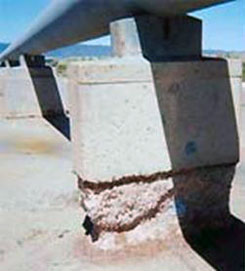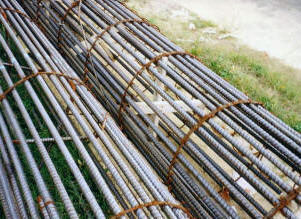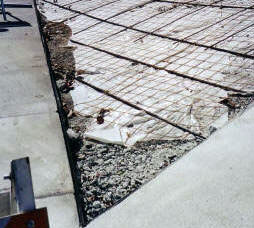Technical Information
Although concrete is one of the most utilized building materials in the world, its use has, in the past, been limited for green roofs. Because of its inherent porosity and ability to absorb water, the structural use of regular concrete requires a membrane to waterproof it.

There are only three ways water can get through concrete: via joints, cracks/voids, and by permeability or absorption from capillary action. If all three of these water transport mechanisms can be shut down, concrete would then be truly waterproof and could be used successfully in a greenroof application, eliminating the need for membranes and coatings.
As we all know, water is a necessary ingredient in concrete. When the concrete is placed, the water escapes, leaving microscopic capillary tubes in its place. Unfortunately, water can come right back into these capillaries. Essentially, this capillary action makes the concrete itself into a gigantic sponge. Thus for a greenroof application, regular concrete always needs a membrane.
Fortunately, a method exists to make concrete totally waterproof.
In the 1950s, Mr. Peter Aldred in Australia invented an admixture that is mixed into a high quality concrete, shutting down the capillary transport of water through the concrete matrix. With the waterproof concrete system, the concrete takes on “hydrophobic” properties. Water is actually repelled by this type of concrete. In addition, the admixture leaves complex polymers that line all of the aforementioned capillaries. When water tries to re-enter under pressure, the polymers simply compact, plugging the capillary, just like a dirty drain would be plugged. This renders the concrete truly waterproof.
The British Board of Agreement has approved this system, stating that “The system can provide waterproof concrete for basements, swimming pools, roofs, tunnels, and other similar situations.” Since water can no longer re-enter the concrete matrix, it cannot transport dissolved salts, sulfates, chlorides, acids, etc. which serve to deteriorate both the concrete and any reinforcing steel or other imbedded objects. Thus this concrete also has tremendous durability in applications which these agents are a problem for normal concrete. For instance, in a green roof, the sulfates in some soils and fertilizers cannot attack this type of concrete.
Addressing Cracks and Voids
In order to prevent cracks and voids, the waterproof concrete system is provided with a super plasticizer that allows the contractor to place the concrete at a high slump to fill voids and provide workability and while still retaining a low water-cement ratio. This admixture also lowers shrinkage, which is the main cause of cracking. To further eliminate cracks, the concrete for the waterproof system is reinforced with synthetic fibers.
 For greenroof applications, a post-tensioned concrete system is the most common. Post-tensioned reinforcing consists of very high strength steel strands which have a tensile strength of 270,000 pounds per square inch. In comparison, a typical piece of reinforcing (rebar) has a tensile strength of 60,000 psi. Strands are stressed to a force of 33,000 pounds using a hydraulic jack. The steel is housed in a sheathing to allow it move as the tensioning force is applied after the concrete cures. The steel stretches as it is tensioned, and it is locked into place using an anchoring component that forms a mechanical connection and keeps the force in the strand for the life of the structure.
For greenroof applications, a post-tensioned concrete system is the most common. Post-tensioned reinforcing consists of very high strength steel strands which have a tensile strength of 270,000 pounds per square inch. In comparison, a typical piece of reinforcing (rebar) has a tensile strength of 60,000 psi. Strands are stressed to a force of 33,000 pounds using a hydraulic jack. The steel is housed in a sheathing to allow it move as the tensioning force is applied after the concrete cures. The steel stretches as it is tensioned, and it is locked into place using an anchoring component that forms a mechanical connection and keeps the force in the strand for the life of the structure.
Post-tensioning also helps to resist the development of shrinkage cracks. Shrinkage cracks, while typically not detrimental to the performance of the structure, can be unsightly, and can allow the passage of moisture. Post-tensioning tends to minimize any future cracking, as well.
Waterproofing Joints and Penetrations
 Joints and penetrations are specially designed with special sodium bentonite strips. Usually, De Neef’s Swellseal 2010 is used, which is a flexible extruded vulcanized strip (¾” x ⅜”) made of a combination of chloroprene rubber and a hydrophilic resin. This is a new-generation rubber with a swelling capacity of 200%. It is pretreated with a twelve-hour delay coating to prevent swelling from the bleed water in the concrete. These serve as waterproofing for the joints and around any penetrations for pipes, vents, etc. Designers can follow time proven methods to eliminate leakage problems from jointing.
Joints and penetrations are specially designed with special sodium bentonite strips. Usually, De Neef’s Swellseal 2010 is used, which is a flexible extruded vulcanized strip (¾” x ⅜”) made of a combination of chloroprene rubber and a hydrophilic resin. This is a new-generation rubber with a swelling capacity of 200%. It is pretreated with a twelve-hour delay coating to prevent swelling from the bleed water in the concrete. These serve as waterproofing for the joints and around any penetrations for pipes, vents, etc. Designers can follow time proven methods to eliminate leakage problems from jointing.
The Costs of the Waterproof Concrete System
How does it compare to other waterproofing schemes for greenroof applications? Since this is a liquid admixture that goes with a specific concrete mix, the pricing is per square foot not including the concrete, since the concrete is a structural element that would otherwise need waterproofing. At six inches thick, this system costs approximately two dollars per square foot. At ten inches thick, the cost would increase to three dollars per square foot. This price would include design assistance for joints and penetrations, on site pre-pour inspection as well as inspection during concrete placement and as quality assurance at the ready mix plant and on the jobsite. The limitation of using this system is that it usually cannot be applied in a greenroof retrofit because of the structural weight of the concrete. Applications are usually limited to new construction where the structural requirements are part of the engineering and design considerations. In very thick segments, it can also be quite costly, since the system is utilized throughout the entire concrete segment.


